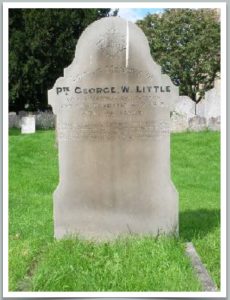5th Reserve Battalion, Guards Machine Gun Regiment

Unfortunately, no Army Service Record or Pension Record papers have survived for Private Little, so there is a lack of firm information about him or his Army service.
Evidence suggests that George William Little was born at Twyning in 1896. His mother, Mary, was the only parent named in his baptismal record. He was baptised in Twyning Parish Church on 27 August 1897 (as William George Little) and a note against the Church record states ‘aged 15 months’).
Mary Little is shown as a single person, aged 47 and a school cleaner, living with her mother in Twyning at the time of the 1911 Census.
That same census shows a George Little, born in 1896, living as a servant at Barrow Court, Boddington, near Cheltenham but it is not certain he was George William Little.
George (if that was the name by which he was known) appears to have joined the Army early in the Great War and was originally posted to the Grenadier Guards, with a service number of 17003.
According to the website armyservicenumbers.blogspot.co.uk the number indicates enlistment in either August of September 1914.
It would appear that he became a specialist machine gunner with the Guards and then transferred to the Guards Machine Gun Regiment, which was the machine gun arm of the Guards Division. He was given the number 1729. The Regiment was not formed until May 1918 and the 5th Reserve Battalion was located at the regimental training centre and so, possibly, George was an instructor there.
The Register of Soldiers’ Effects located at the National Army Museum, contains an entry stating that George Little died at Connaught Hospital, Aldershot on 29 November 1918, aged 22. The cause of death, as shown on a recently released Pension Record Card, was influenza.
He was returned to his home village of Twyning for urial in the local parish churchyard, where a private stone cross now marks his grave.
The church burial record states that burial took place on 8 December 1918 and that his address was Brockeridge Common, Twyning. He is commemorated on the Twyning War Memorial.
Researched by Graham Adams 29 March 2018 (revised 30 July 2021
